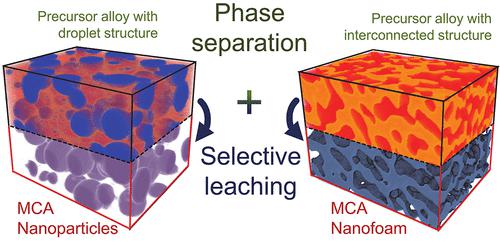当前位置:
X-MOL 学术
›
Acc. Chem. Res.
›
论文详情
Our official English website, www.x-mol.net, welcomes your feedback! (Note: you will need to create a separate account there.)
Pushing the Boundaries of Multicomponent Alloy Nanostructures: Hybrid Approach of Liquid Phase Separation and Selective Leaching Processes
Accounts of Chemical Research ( IF 18.3 ) Pub Date : 2022-06-17 , DOI: 10.1021/acs.accounts.2c00143 Jinwoo Kim 1 , Ji Young Kim 2 , Eun Soo Park 2
Accounts of Chemical Research ( IF 18.3 ) Pub Date : 2022-06-17 , DOI: 10.1021/acs.accounts.2c00143 Jinwoo Kim 1 , Ji Young Kim 2 , Eun Soo Park 2
Affiliation

|
Alloying, or mixing of multiple metallic elements, is the classical way of novel materials development since the Bronze age. Increased numbers of principal elements expand the compositional space for alloy design vastly, leading to nearly endless possibilities of unexpected and unique materials properties. In contrast to bulk alloying processes represented by casting of molten metal mixtures, the fabrication of multicomponent alloy (MCA) nanostructures such as nanoparticles and nanofoams with more than three elements is often challenging, and a few methodologies for directly synthesizing alloy nanostructures up to denary systems have been suggested recently. However, forming alloy nanoparticles inside another metal matrix, instead of inside aqueous media in wet-chemical synthesis, is a fairly well understood strategy in terms of physical metallurgy. Extracting those alloy nanophases from the matrix could provide an alternative way to fabricate novel MCA nanostructures.
中文翻译:

突破多组分合金纳米结构的边界:液相分离和选择性浸出过程的混合方法
合金化或多种金属元素的混合是自青铜时代以来新型材料开发的经典方式。主要元素数量的增加极大地扩展了合金设计的组成空间,导致了几乎无限的意想不到的独特材料特性的可能性。与以熔融金属混合物铸造为代表的块状合金化工艺相比,多组分合金 (MCA) 纳米结构(例如具有超过三种元素的纳米颗粒和纳米泡沫)的制造通常具有挑战性,并且一些直接合成合金纳米结构的方法达到了 Denary 系统最近有人建议。然而,在湿化学合成中,在另一种金属基质内而不是在水性介质内形成合金纳米粒子,就物理冶金而言,这是一个相当容易理解的策略。从基质中提取这些合金纳米相可以提供一种制造新型 MCA 纳米结构的替代方法。
更新日期:2022-06-17
中文翻译:

突破多组分合金纳米结构的边界:液相分离和选择性浸出过程的混合方法
合金化或多种金属元素的混合是自青铜时代以来新型材料开发的经典方式。主要元素数量的增加极大地扩展了合金设计的组成空间,导致了几乎无限的意想不到的独特材料特性的可能性。与以熔融金属混合物铸造为代表的块状合金化工艺相比,多组分合金 (MCA) 纳米结构(例如具有超过三种元素的纳米颗粒和纳米泡沫)的制造通常具有挑战性,并且一些直接合成合金纳米结构的方法达到了 Denary 系统最近有人建议。然而,在湿化学合成中,在另一种金属基质内而不是在水性介质内形成合金纳米粒子,就物理冶金而言,这是一个相当容易理解的策略。从基质中提取这些合金纳米相可以提供一种制造新型 MCA 纳米结构的替代方法。


























 京公网安备 11010802027423号
京公网安备 11010802027423号